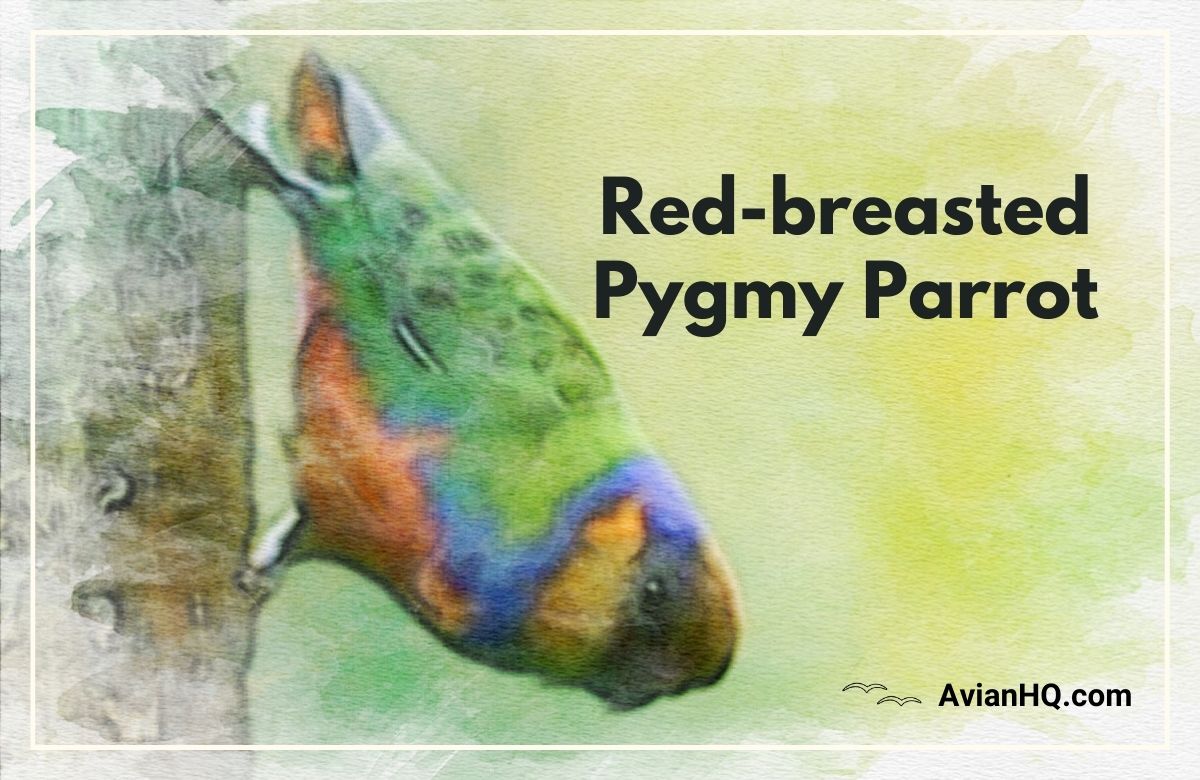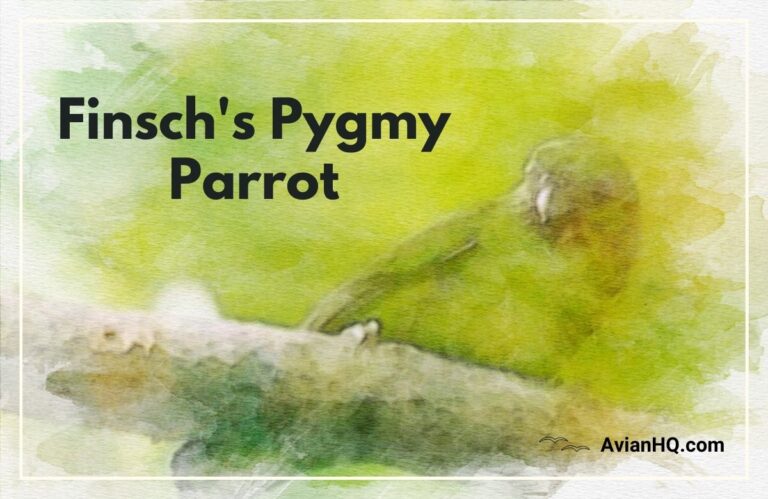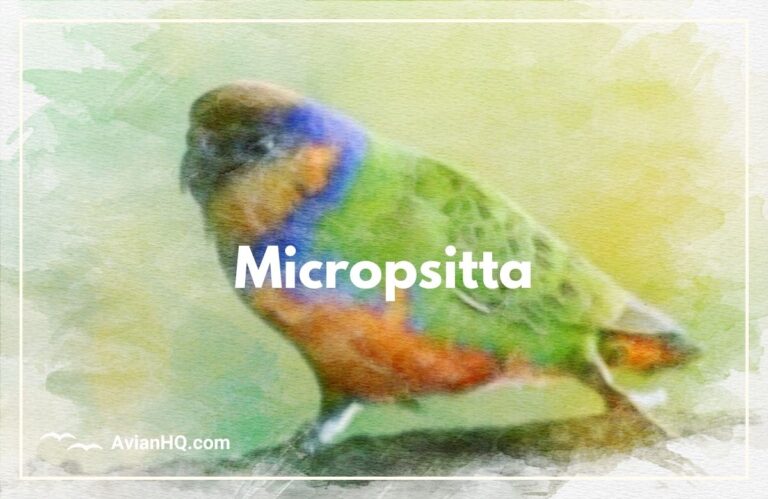Red-breasted Pygmy Parrot (Micropsitta bruijnii)
Imagine yourself deep in the mountainous rainforests of New Guinea or the tropical islands of the Maluku archipelago. As you traverse along a ridge or winding forest trail, a flash of brilliant color suddenly flits past. Glancing up, you spot a tiny parrot, hardly larger than your hand, perched on a nearby branch. It’s vibrant red crown and breast stand out dramatically from the green plumage covering the rest of it’s body. What you’ve spotted is likely the red-breasted pygmy parrot, one of the world’s smallest parrot species.
Reaching just 3-3.5 inches (9 cm) in length and weighing only 0.4-0.6 ounces (12-16 grams), the diminutive red-breasted pygmy parrot makes up for it’s tiny size with it’s oversized personality. It’s high-pitched squeaks and chirps echo through the forest canopy as these tiny acrobatic birds flit from tree to tree. Quickly hopping along branches and even hang upside down at times, their movements appear more reminiscent of nimble tree-creepers than slow-moving parrots.
The red-breasted pygmy parrot remains one of the lesser known parrot species due to it’s remote habitat and shy nature. But to those fortunate enough to stumble across one, observing these colorful sprites in their mountain forest realm is an unforgettable experience. This article will explore the natural history, physical appearance, habitat, ecology, conservation status and cultural significance of the elusive red-breasted pygmy parrot.
History and Taxonomy
The red-breasted pygmy parrot was first described scientifically in 1875 by Italian ornithologist Tommaso Salvadori. He assigned the species the binomial name Micropsitta bruijnii, classifying it within the newly created genus Micropsitta. The genus name Micropsitta derives from the Greek words “mikros” meaning small and “psittakos” meaning parrot, an apt descriptor for these tiny birds.
The species name bruijnii honors Antonie Augustus Bruijn, a Dutch merchant who collected bird specimens on islands across present-day Indonesia during the 19th century. Many of those specimens, including the first red-breasted pygmy parrots collected by Bruijn himself, were later sent to museums in Europe where ornithologists like Salvadori were able to study them.
Today, the red-breasted pygmy parrot is recognized as comprising five distinct subspecies:
- M. b. bruijnii – mountains of New Guinea
- M. b. buruensis – Buru Island
- M. b. necopinata – New Britain and New Ireland Islands
- M. b. pileata – Seram Island
- M. b. rosea – Bougainville, Guadalcanal and Kolombangara Islands
The nominate subspecies M. b. bruijnii inhabits various mountain ranges across the mainland of New Guinea, including the Bird’s Head Peninsula in the west to the Owen Stanley Range in the east. It occurs at elevations between 1,640-7,544 feet (500-2,300 m).
The other subspecies are endemic to individual islands or island groups across New Guinea, the Maluku Islands, the Bismarck Archipelago, and the Solomon Islands. Each subspecies possesses slight variations in plumage coloration and patterning.
Physical Appearance
The red-breasted pygmy parrot is a tiny bird, measuring approximately 3-3.5 inches (9 cm) in length and weighing just 0.4-0.6 ounces (12-16 grams). It’s wingspan ranges from 5.5-6 inches (14-15 cm).
Males and females exhibit distinctive plumage. Adult males have bright grass green upperparts from the nape down. The crown is a vivid red, orange or pink that varies between subspecies. The lower nape and hindneck are iridescent sky blue, forming a collar that extends around to the throat. The cheeks, ear coverts and throat are also pale pinkish-orange.
The underparts are light pinkish-red at the center, with an iridescent blue band across the upper breast below the neck collar. The lower flanks and undertail coverts fade to green. The central tail feathers are dark blue dotted with black, and the outer tail feathers are black with yellow-orange tips.
Females lack most of the bright red and blue plumage of the males. They are predominantly green overall, with a purplish-blue crown, white forecrown and pale greyish white cheeks and throat. Immature birds resemble adult females.
The bill of both sexes is pale horn-colored with a grey base. The eyes are brown and the legs and feet are gray.
The various subspecies show minor differences in the exact hue and extent of the red and blue plumage markings. But all share the same basic pattern of red or orange heads, blue collars and pinkish underparts on the males.
Habitat and Distribution
The red-breasted pygmy parrot occupies mountain forest habitats across a remote and fragmented range spanning New Guinea, the Maluku Islands, the Bismarck Archipelago and Solomon Islands. It’s total global range covers an estimated 269,000 sq km (104,000 sq mi).
This species typically occurs at elevations between 1,640-7,544 feet (500-2,300 m), though it has been spotted as low as sea level on occasion. It inhabits primary and secondary montane rainforests, forest edges, and wooded ravines.
On New Guinea, the red-breasted pygmy parrot can be found in various mountain ranges across the island, including the Tamrau and Arfak Mountains in the west, the Kubor and Bismarck Ranges in the interior highlands, and the Owen Stanley Range in the southeast.
The M. b. bruijnii subspecies occupies mainland New Guinea. M. b. buruensis is endemic to Buru Island, while M. b. pileata inhabits Seram Island. Both islands are part of the southern Maluku archipelago.
M. b. necopinata resides on the islands of New Britain and New Ireland in the Bismarck Archipelago northeast of New Guinea. Finally, M. b. rosea is native to Bougainville, Guadalcanal and Kolombangara Islands in the Solomon Islands chain southeast of New Guinea.
Though shy and easily overlooked, the red-breasted pygmy parrot can be locally common within suitable montane forest habitat across it’s insular range.
Diet and Feeding
The diet of the red-breasted pygmy parrot consists primarily of lichens and fungi gleaned from the bark and branches of trees. This unusual diet gives them access to food sources that most other tropical forest birds do not utilize.
They have also been observed feeding on various fruits, seeds and flowers on occasion. Some of the plant species they are known to visit include Schefflera trees and shrubs, which provide nectar and pollen.
Foraging takes place high in the forest canopy. The pygmy parrots use their slim pointed bills to pick at bark crevices and probe into clumps of lichen and moss. Their unique bacteria-digesting gizzard allows them to consume the lichens that make up the bulk of their diet.
Unlike larger parrot species, red-breasted pygmy parrots do not destroy significant amounts of plant material when feeding. They delicately pluck fungi and lichens, ingesting only tiny pieces at a time.
Pygmy parrots may forage alone, in pairs, or in small flocks of up to 20 individuals. This species is most active in early morning and late afternoon. They regularly visit and appear to prefer dead, damaged or decaying trees laden with fungi, spending more time perched and feeding in these trees compared to live, healthy ones.
Breeding and Reproduction
The breeding season for red-breasted pygmy parrots extends from December to April. They nest in natural cavities in dead tree snags rather than in arboreal termite mounds like most other pygmy parrots.
Nest hollows are located 3-13 feet (1-4 m) above ground. The entrance consists of a tunnel leading to a back chamber about 4 x 2 inches (100 x 55 mm) across. The interior is often lined with wood chips.
Clutch size is typically around 4 white rounded eggs measuring 0.7 x 0.5 inches (17.5 x 14 mm) in size. The female incubates the eggs while being fed by the male. Incubation period and nestling time are unknown.
Red-breasted pygmy parrots are thought to be monogamous. One nest was recorded containing a male along with two females, suggesting this species may occasionally practice polygyny.
Both parents share feeding responsibilities once the chicks hatch. The chicks are altricial and slow-growing, taking their time to develop before fledging from the nest.
Breeding pairs appear to be territorial and may reuse the same nest hollow in subsequent years. Not much else is known about their breeding habits and behavior due to the difficulty observing them within their remote forest habitat.
Behavior and Ecology
The red-breasted pygmy parrot is most active in early morning and late afternoon hours. It spends the hottest part of the day quietly perched within the forest canopy.
Though seldom seen, their loud high-pitched squeaks and rattling choruses reveal their presence. Their vocalizations include various chirps, chatters, and whistle-like contact calls.
They are quick and agile fliers capable of sudden vertical takeoffs and direction changes. Movements appear almost frenetic as they hop along branches probing for lichens and fungi. They may hang upside down at times while feeding.
Red-breasted pygmy parrots are usually encountered in pairs or small flocks of up to 20 individuals. Mixed foraging flocks may form between breeding seasons. They also associate with other pygmy parrot species on occasion.
Flocks maintain contact through constant vocal communication as they work through the trees. Some level of hierarchy may exist, with particular birds initiating flock movements or taking the lead.
Not much is known about their social behaviors and interactions. Displays like preening, bill-nibbling, and grooming take place between paired birds.
Predators likely include tree-climbing snakes and arboreal mammals capable of raiding nests. However, their specialized arboreal existence provides relative safety from most ground predators.
Conservation Status
The red-breasted pygmy parrot is evaluated as Least Concern on the IUCN Red List of Threatened Species. It’s total population size is unknown but suspected to be relatively stable based on observations across it’s range.
However, it’s remote and fragmented island habitat makes it difficult to accurately survey populations. The species has vanished from some formerly inhabited islands, suggesting it may be in gradual decline.
Major threats include deforestation, logging, agricultural expansion, mining, and habitat degradation. It’s small population size and dependence on primary montane forest makes it vulnerable to extinction if forest loss continues.
Fortunately, much of it’s range occurs in remote mountains that have experienced little development so far. But increased human activities pose an ever-present threat.
Around 33-66% of the land within it’s range has some level of legal protection. But many protected areas still suffer from illegal logging and encroachment. Stronger enforcement of park boundaries and hunting laws are needed to ensure adequate habitat remains to sustain wild populations.
Increased surveying efforts, population monitoring, and field studies focused on it’s ecology would help support future conservation actions for this poorly known species. Raising local community awareness and expanding environmental education programs are also recommended.
Cultural Significance
The red-breasted pygmy parrot has little significance in the folklore or cultural traditions of indigenous peoples across it’s range. This is likely due to it’s remote habitat and shy, unobtrusive nature that keeps it hidden from view.
Local tribes living in the mountain forests of New Guinea were presumably aware of these tiny birds, and may have incorporated them into spiritual belief systems or myths. But if so, they left no enduring oral histories or artifacts reflecting this.
The parrot’s small size, unusual diet, and subtly-colored plumage fail to capture the human imagination in the way larger, more flashy bird species often do. It does not contribute significantly to local economies as a food source, pet trade item, or tourist attraction.
To the limited number of modern birdwatchers who stumble across one, observing a red-breasted pygmy parrot in the wild is considered an exceptionally rare treat. But beyond these obscure birding circles, the species remains almost wholly unknown.
If the red-breasted pygmy parrot has any cultural significance at all, it is in the outsized ecological role it fills in dispersing fungi and lichen spores throughout it’s montane forest ecosystem. But this is a subtle biological relationship only fully appreciated by scientists.
To the extent this diminutive parrot enters public awareness, it is as an obscure name on a list or colorful illustration in a field guide. It awaits wider appreciation by conservations and ecologists for the unique niche it occupies in it’s New Guinean mountain habitats.
Conclusion
The elusive red-breasted pygmy parrot remains one of the least studied and most enigmatic parrot species in the world. It’s tiny size belies the outsized role it plays in dispersing lichens and fungi while foraging through New Guinean and Malukan mountain forests.
Yet despite being locally common, it’s remote island habitat and shy nature have kept it hidden from science and the public eye for decades. As one of the smallest parrots, reaching just 3-3.5 inches (9 cm) and 0.4-0.6 ounces (12-16 grams), it compensates with acrobatic climbing abilities allowing it to extract fungi and lichens other tropical birds cannot access.
With a vibrant red or orange crown and breast patching set against bright green plumage, the males offer a quick flash of color as they flit through the high canopy. The species’ unique traits, from it’s unusual diet to it’s rainforest home, give it a prime spot in avian biodiversity worth conserving.
However, deforestation and habitat loss across it’s island range pose increasing threats. Greater protections for the remote montane forests this species inhabits are needed to ensure the red-breasted pygmy parrot persists far into the future.
Though it lacks cultural significance, biologically the red-breasted pygmy parrot fills an important niche. Raising awareness and appreciation for this little-known species can help spark interest in protecting New Guinea’s rich but imperiled rainforest environments.







